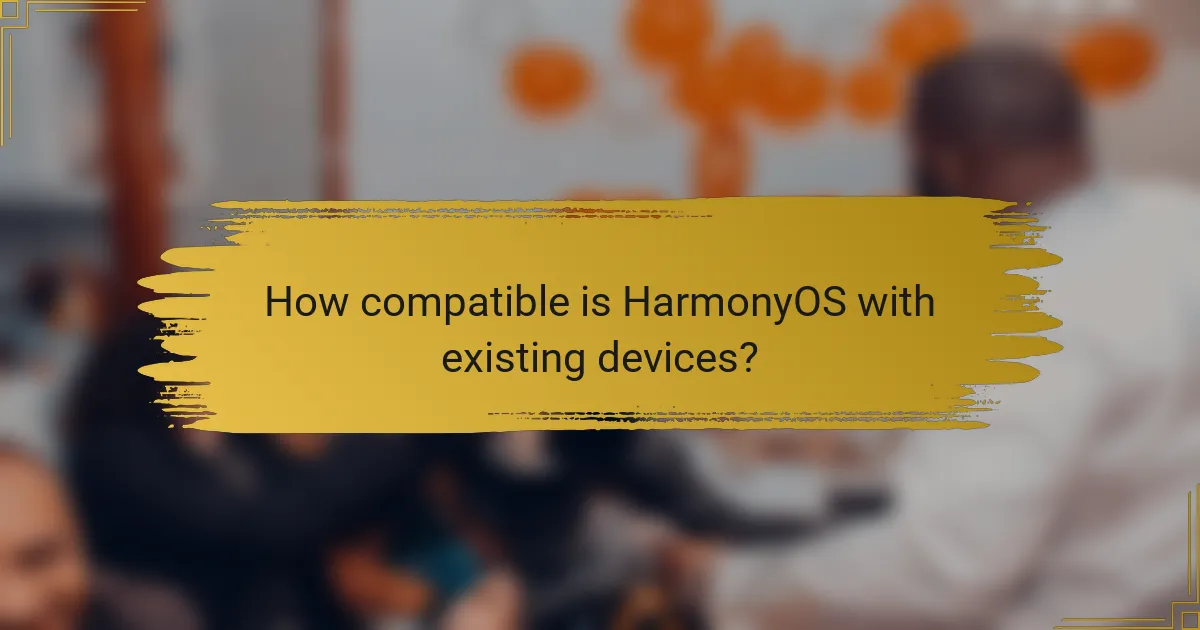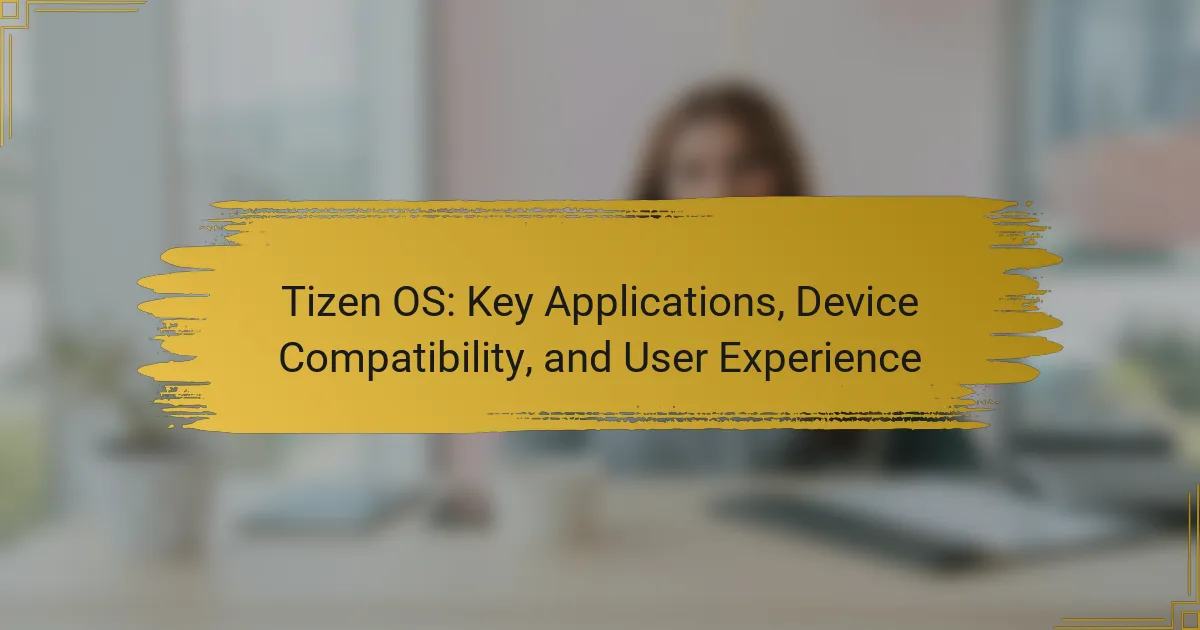HarmonyOS is an operating system developed by Huawei, designed for smartphones, tablets, and IoT devices. It employs a microkernel architecture to enhance security and performance while promoting a seamless user experience across various platforms. Launched in 2019, HarmonyOS supports multiple application development frameworks, allowing developers to create apps compatible with various device types. The system’s distributed architecture facilitates multi-device collaboration and shared services, while its compatibility with existing Huawei devices enables upgrades for many models. With promising future prospects, HarmonyOS aims to expand its global market presence and improve interoperability among diverse devices.

What is HarmonyOS?
HarmonyOS is an operating system developed by Huawei. It is designed for a wide range of devices, including smartphones, tablets, and IoT devices. HarmonyOS aims to create a seamless and interconnected user experience across different platforms. The system utilizes a microkernel architecture, which enhances security and performance. Launched in 2019, HarmonyOS supports various application development frameworks. It allows developers to create apps that can run on multiple device types. The operating system is part of Huawei’s strategy to reduce reliance on foreign technology. HarmonyOS has been adopted in several regions, contributing to Huawei’s ecosystem expansion.
How does HarmonyOS differ from other operating systems?
HarmonyOS differs from other operating systems by its ability to seamlessly connect and integrate multiple device types. It is designed to operate across various platforms, including smartphones, tablets, smart TVs, and IoT devices. This cross-device compatibility enhances user experience by allowing for a unified ecosystem. Unlike traditional operating systems, HarmonyOS utilizes a microkernel architecture for improved performance and security. This architecture enables faster response times and lower resource consumption. Additionally, HarmonyOS supports distributed technology, enabling applications to run on different devices simultaneously. This feature is not commonly found in other operating systems. Overall, HarmonyOS aims to create a more interconnected and efficient digital environment.
What are the core principles behind HarmonyOS design?
HarmonyOS is designed around several core principles that enhance user experience and system performance. These principles include seamless interconnectivity, distributed architecture, and user-centric design. Seamless interconnectivity allows devices to communicate effortlessly, creating a cohesive ecosystem. The distributed architecture enables resource sharing across devices, optimizing performance and efficiency. User-centric design focuses on intuitive interfaces and accessibility, enhancing usability for diverse users. Together, these principles ensure HarmonyOS delivers a versatile and adaptive operating system for various devices.
How does HarmonyOS support multi-device connectivity?
HarmonyOS supports multi-device connectivity through a feature called Distributed Technology. This technology allows seamless interaction between various devices, such as smartphones, tablets, wearables, and smart home devices. HarmonyOS enables users to access and control multiple devices from a single interface. It creates a unified experience by allowing applications to run across different devices without needing separate installations. The system uses a shared architecture that optimizes resource allocation and enhances performance. For instance, users can initiate a video call on their smartphone and switch to a tablet mid-call without interruption. This capability is backed by Huawei’s emphasis on ecosystem integration, ensuring that devices communicate effectively.
What unique features does HarmonyOS offer?
HarmonyOS offers unique features such as distributed technology, which enables seamless connectivity across multiple devices. It allows applications to run across various hardware seamlessly. The system supports a microkernel architecture, enhancing security and performance. HarmonyOS also incorporates a unique user interface designed for fluid interactions. Additionally, it features a cross-device collaboration capability, allowing users to share resources effortlessly. The operating system is designed to adapt to different screen sizes and device types. These features collectively enhance user experience and device interoperability.
How does the distributed architecture enhance user experience?
Distributed architecture enhances user experience by enabling seamless integration across devices. This architecture allows applications to run on multiple devices simultaneously. Users can access services from their smartphones, tablets, or smart home devices without interruption. The system’s ability to share resources improves performance and responsiveness. For instance, tasks can be offloaded to the device best suited for them, optimizing processing power. This leads to faster load times and smoother interactions. Additionally, distributed architecture supports real-time data synchronization. This ensures that user preferences and settings are consistent across all devices. Overall, it creates a more cohesive and efficient user experience.
What role does AI play in HarmonyOS functionality?
AI enhances HarmonyOS functionality by enabling intelligent user interactions and optimized system performance. It facilitates features like smart device management and predictive resource allocation. AI algorithms analyze user behavior to personalize experiences. This leads to improved efficiency in task execution and energy consumption. HarmonyOS integrates AI for seamless connectivity across devices. The system learns from user patterns to anticipate needs. This adaptability enhances overall user satisfaction. AI’s role is crucial for the future development of HarmonyOS, ensuring it remains competitive in the evolving tech landscape.

How compatible is HarmonyOS with existing devices?
HarmonyOS is designed to be compatible with a range of existing devices. It supports various hardware platforms, including smartphones, tablets, and IoT devices. HarmonyOS can run on devices with different architectures, such as ARM and x86. The system utilizes a distributed architecture, allowing seamless interaction between devices. Users can experience features like multi-device collaboration and shared services. Compatibility extends to Huawei’s previous devices, enabling upgrades for many existing models. This adaptability aims to enhance user experience across diverse ecosystems.
What devices currently support HarmonyOS?
HarmonyOS is currently supported by a range of devices from Huawei. These include smartphones like the Huawei P40 series, Mate 40 series, and Nova series. Additionally, HarmonyOS powers tablets such as the Huawei MatePad series. Smart TVs from Huawei also utilize HarmonyOS for their operating system. Other devices include smart wearables like the Huawei Watch 3 series. This information is based on Huawei’s official announcements and product releases.
How does HarmonyOS integrate with older devices?
HarmonyOS integrates with older devices through a compatibility layer that allows seamless operation. This layer enables older devices to run HarmonyOS applications without requiring significant hardware upgrades. It uses a lightweight architecture to ensure performance is optimized for less powerful hardware. The integration supports various device types, including smartphones and IoT devices, enhancing their functionality. Additionally, HarmonyOS employs a distributed technology that allows older devices to connect and communicate with newer devices effectively. This ensures a cohesive user experience across different generations of devices.
What are the requirements for device compatibility?
Device compatibility with HarmonyOS requires specific hardware and software specifications. Devices must have at least 4GB of RAM for optimal performance. A compatible processor is necessary, ideally from Huawei’s Kirin series or equivalent. The device should support 64-bit architecture to run HarmonyOS efficiently. Additionally, a minimum of 32GB of storage is recommended for system and app installations. The device must also have a display resolution that meets HarmonyOS standards for a smooth user experience. Lastly, firmware must be updated to the latest version to ensure compatibility and security. These requirements ensure that devices can fully utilize the features of HarmonyOS.
What ecosystems does HarmonyOS interact with?
HarmonyOS interacts with various ecosystems including IoT devices, smartphones, tablets, and smart home appliances. It is designed to provide seamless connectivity across these platforms. HarmonyOS enables devices to communicate and share resources efficiently. The ecosystem includes products from Huawei and third-party manufacturers. This interoperability enhances user experience by allowing a unified interface. HarmonyOS supports multiple device types, which expands its ecosystem reach. The integration with smart home devices allows for automation and control from a single platform. This capability positions HarmonyOS as a versatile operating system in the growing IoT landscape.
How does HarmonyOS connect with IoT devices?
HarmonyOS connects with IoT devices through its distributed technology framework. This framework allows seamless communication between various devices. HarmonyOS employs a service-oriented architecture, enabling different devices to share resources efficiently. It supports multiple communication protocols, including Wi-Fi, Bluetooth, and Zigbee. This versatility ensures compatibility with a wide range of IoT devices. Moreover, HarmonyOS utilizes a unified development environment for developers. This environment simplifies the creation of applications that can operate across different devices. The integration of AI enhances the interaction between HarmonyOS and IoT devices. This leads to improved automation and smart functionality in connected environments.
What partnerships enhance HarmonyOS compatibility?
Partnerships that enhance HarmonyOS compatibility include collaborations with major tech companies such as Qualcomm and Microsoft. Qualcomm provides chipsets that support HarmonyOS devices, ensuring optimized performance. Microsoft’s partnership enables seamless integration with Windows applications, enhancing cross-platform functionality. Additionally, Huawei collaborates with various app developers to expand the HarmonyOS ecosystem. These partnerships collectively improve device interoperability and user experience.

What are the future prospects of HarmonyOS?
The future prospects of HarmonyOS appear promising. HarmonyOS aims to create a seamless ecosystem across various devices. It supports multiple device types, including smartphones, wearables, and IoT devices. The operating system is designed to enhance interoperability among these devices. As of 2023, Huawei has reported significant adoption rates in China. The company aims to expand its market presence globally. Partnerships with other manufacturers could further boost its ecosystem. Additionally, ongoing updates and feature enhancements are expected to improve user experience.
How is HarmonyOS expected to evolve in the coming years?
HarmonyOS is expected to evolve through enhanced integration across devices and improved user experience. The operating system aims to unify various hardware platforms, including smartphones, tablets, and IoT devices. Future updates will likely introduce advanced AI features for smarter interactions. Increased developer support is anticipated to expand the app ecosystem significantly. Huawei has committed to regular updates that improve system security and performance. As of now, HarmonyOS supports over 200 million devices, showcasing its growing adoption. The evolution of HarmonyOS is also influenced by global market trends and user feedback.
What advancements are planned for HarmonyOS features?
HarmonyOS plans to introduce several advancements in its features. These include enhanced cross-device collaboration capabilities. Users will experience improved integration between smartphones, tablets, and smart home devices. The operating system aims to bolster privacy and security features significantly. Upgraded AI functionalities are also on the roadmap, focusing on personalized user experiences. Enhanced app compatibility will allow for a broader range of applications across devices. Furthermore, HarmonyOS is set to optimize performance and battery efficiency in upcoming updates. These advancements reflect Huawei’s commitment to evolving HarmonyOS as a versatile ecosystem.
How will HarmonyOS impact the global tech landscape?
HarmonyOS will significantly impact the global tech landscape by promoting interoperability across devices. This operating system is designed to unify various hardware, enhancing user experience. HarmonyOS supports multiple device types, including smartphones, tablets, and IoT devices. Its architecture allows seamless communication between these devices, fostering a more connected ecosystem.
The system’s ability to run on diverse hardware can challenge existing OS dominance, particularly in markets where Android and iOS are prevalent. As of 2023, HarmonyOS has been adopted by over 300 million devices, indicating its growing influence. This adoption rate suggests a potential shift in consumer preferences towards a more integrated technology experience.
The global tech landscape may also see increased competition among OS developers, driving innovation and improvements. Manufacturers may explore HarmonyOS to differentiate their products, impacting market dynamics. Overall, HarmonyOS is poised to reshape how users interact with technology on a global scale.
What challenges does HarmonyOS face moving forward?
HarmonyOS faces several challenges moving forward. One major challenge is achieving widespread adoption among developers. Limited app availability hampers user experience and hinders growth. Additionally, competition from established operating systems like Android and iOS presents significant obstacles. These rivals have extensive ecosystems and user bases. Furthermore, ensuring compatibility with a range of devices is crucial for success. HarmonyOS must also navigate regulatory scrutiny in various markets. This includes addressing privacy and security concerns effectively. Overall, these challenges will require strategic planning and execution to overcome.
How can HarmonyOS overcome competition in the market?
HarmonyOS can overcome competition in the market by emphasizing its unique features and seamless integration across devices. Its architecture supports a wide range of devices, from smartphones to IoT devices, enhancing user experience. HarmonyOS utilizes distributed technology, allowing applications to run smoothly across different hardware. This interoperability can attract developers, encouraging a richer app ecosystem. Huawei’s extensive ecosystem, including hardware and services, strengthens HarmonyOS’s market position. Additionally, strategic partnerships with other manufacturers can expand its reach and user base. The growing demand for smart home solutions aligns with HarmonyOS’s capabilities, positioning it favorably in emerging markets. These factors collectively enhance its competitiveness against established operating systems.
What user feedback has been gathered to shape future updates?
User feedback has highlighted several areas for improvement in HarmonyOS. Users have requested enhanced app compatibility and smoother performance. Feedback also indicates a desire for more customization options in the user interface. Additionally, users expressed concerns about battery life and system stability. This feedback is being analyzed to prioritize features for future updates. Data from user forums and surveys supports these findings. Continuous user engagement will guide the development roadmap.
What are the best practices for users adopting HarmonyOS?
Users adopting HarmonyOS should prioritize familiarizing themselves with its interface and features. Understanding the settings and customization options enhances user experience. Regularly updating the OS ensures access to the latest features and security patches. Utilizing Huawei’s ecosystem of devices maximizes HarmonyOS functionality. Users should explore the AppGallery for compatible applications tailored for HarmonyOS. Engaging with community forums can provide valuable tips and support. Backing up data before transitioning to HarmonyOS is crucial for data security. Lastly, users should take advantage of available tutorials and guides to ease the learning curve.
HarmonyOS is an operating system developed by Huawei, designed for a variety of devices including smartphones, tablets, and IoT devices. The article explores HarmonyOS’s unique features such as distributed technology, microkernel architecture, and multi-device connectivity, highlighting its advantages over traditional operating systems. It also examines the compatibility of HarmonyOS with existing devices, its integration with IoT ecosystems, and the partnerships that enhance its functionality. Additionally, the article discusses the future prospects of HarmonyOS, including planned advancements, challenges faced, and user feedback that will shape its evolution in the tech landscape.



